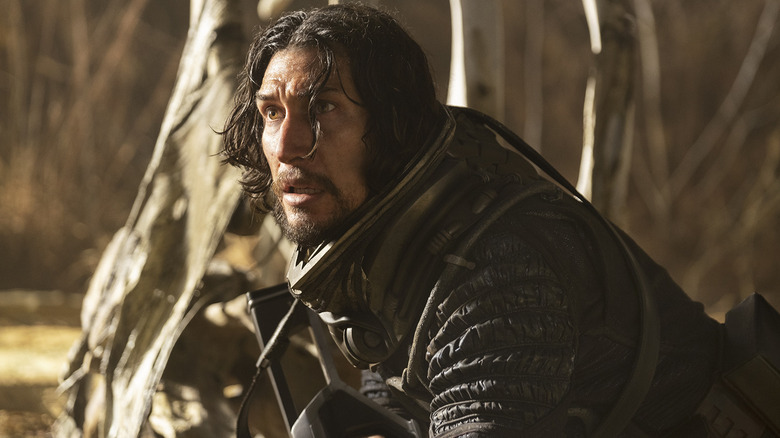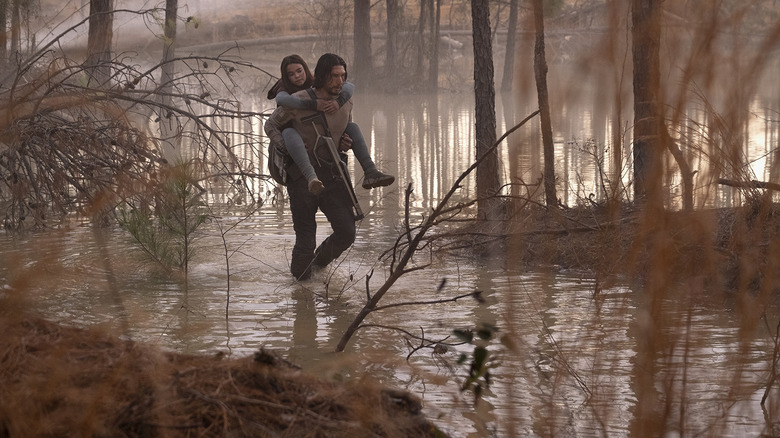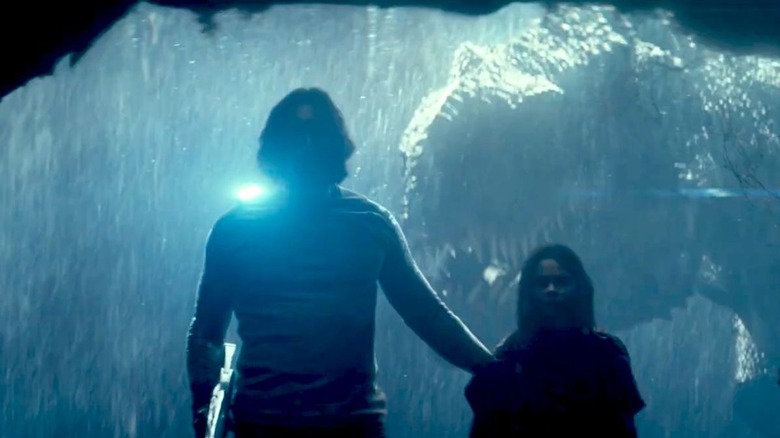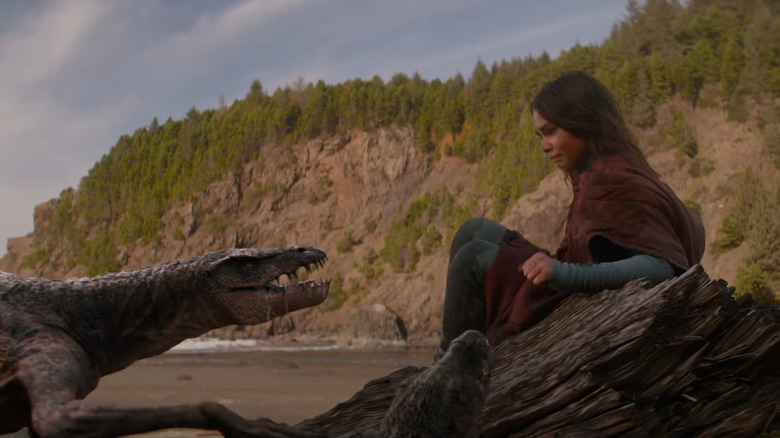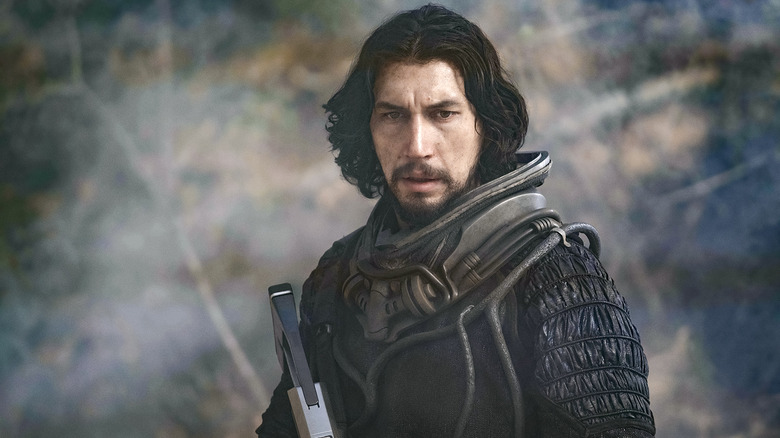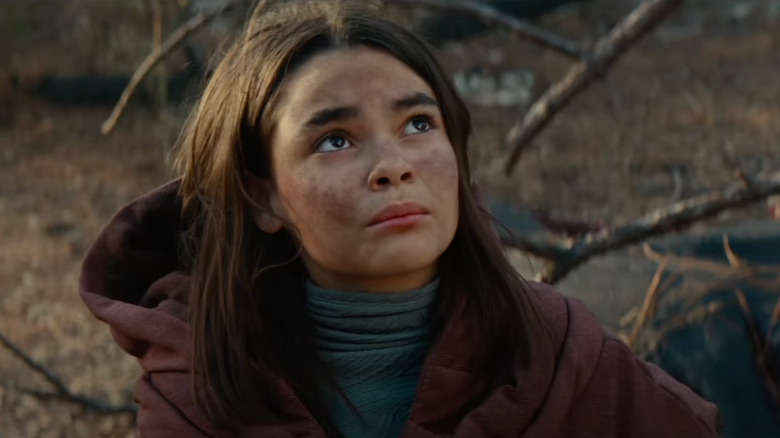65 Directors Beck/Woods Reveal The Secret Of Making An Effective Monster Movie [Exclusive Interview]
It's hard to believe that the film "65," short for "65 Million Years Ago," is a real movie. Produced by genre legend Sam Raimi, the newest feature film from Scott Beck and Bryan Woods ("A Quiet Place," "Haunt,") stars Adam Driver and Ariana Greenblatt as two human-like beings from beyond the galaxy who crash land on an unexplored alien planet. Despite their advanced technology and space-age weaponry, these are not beings from the future, but 65 million years ago. The planet they crash onto turns out to be our own mother Earth.
The result is a sci-fi adventure film that sounds like something straight out of a child's imagination. Driver's spaceman pilot Mills has to shoot lasers at Cretaceous-era dinosaurs in the hopes of getting him and Greenblatt's young Koa back home to safety. While the leading man has already proven himself as a formidable sci-fi action star thanks to his turn as Kylo Ren in the recent "Star Wars" sequel trilogy films, adding dinosaurs into the mix is stepping into uncharted territory. The result is a film as thrilling as it sounds, but with a shockingly poignant emotional center as two strangers are forced to work together, despite not speaking the same language, to escape the dangerous planet. I was fortunate enough to chat with the writer/director team known as Beck/Woods to chat about "65," and learn what it was like to have their very own dinosaur laser fight.
Note: This interview has been edited for length and clarity.
One part Roland Emmerich, one part Terrence Malick
On paper, the premise of "65" feels like the best possible outcome of a 12-year-old playing Mad Libs, but at the same time, it is filled with just so much heart. How did you find the balance between a dinosaur laser fight and a sad dad story?
Beck: Well, thank you for saying so, because you're talking to two people who met when we were 11 years old, and we started off with our action figures making movies with our "Jurassic Park" figures. But the challenge with this movie was embracing the concept that on paper, as you said, it's kind of like a B-movie concept, but finding an undercurrent of emotion. And so we were fortunate enough to have a collaborator like Adam Driver to come on board and really imbue this character in the way that we had written it, where there's a sense of grief, there's a sense of loss. We kept saying this movie felt like one part Roland Emmerich, but one part Terrence Malick, where there's a bit of character [introspection] and some ambiance that percolates like every single scene. So it's a roller coaster ride that needs to be seen on the big screen, but it also isn't afraid to have these quiet moments that are steeped in pure character.
I agree completely. I was absolutely expecting cool dinosaur/space laser hijinks. And suddenly I was like, "Oh, now I'm in my feels about this. All right. I was not expecting that today."
Beck: Oh, that's great.
Woods: Oh, that's so great to hear.
Making an effective monster movie
So, they're obviously dinosaurs, but it's a monster movie. What makes an effective monster movie?
Woods: I think a great monster movie has to be dramatically supported by a good idea, a good concept, by great characters. It's not enough to just have a cool design. Hopefully, the audience is feeling things one way or the other about the creature that you're presenting. When I think about "Jaws," does the shark look amazing? Not always, but it's so well dramatically supported with a great cast of characters giving wonderful performances and really supported by a vision that [leaves] a lot of it up to the audience's imagination. [We talked] a lot about that with "A Quiet Place" and "65": Oftentimes it's about what you don't see that's the most effective. We love when the audience is able to participate and kind of lend their creativity to the film and as filmmakers make us look better. A great example of that is a film like "Blair Witch Project" where, I mean, you don't see anything in that movie, but you hear these terrifying sounds and you just start kind of conjuring up what the monster is in the movie, even without ever seeing anything.
"The Blair Witch Project" came out when I was nine, and I fully believed it was real for about two years.
Woods: Me too! I mean, not two years, but I as a young person enjoyed camping and saw that movie and was like, "Never again. Nope. Never again."
Going beyond Jurassic Park
Earlier you mentioned the "Jurassic Park" figures, and I think when it comes to cinematic dinosaurs, everyone's brains go to "Jurassic Park."
Beck: Yeah.
It's an inevitable comparison. So knowing that's something you're up against, did that change or influence your approach to how you presented dinosaurs in your movie?
Beck: Yeah, I think the approach for "65" is that we want to make dinosaurs scary again. We want to transport audiences back 65 million years ago and show them what it actually could be like if you're all alone on planet Earth, there are no other human beings around, and there's this raw, powerful nature of what Earth was at that time, but also the threat of dinosaurs and predators coming after you at any single moment. "Jurassic Park" takes place in modern day and some of the dinosaur designs, as much as we love them, they start feeling a little cute and a little too precious. So for us, we really wanted to lean into the horror aspect of what dinosaurs could feel like. In the same way that if you're on a safari and all of a sudden you're thrown into the wilderness, you have to find a way to survive, and there's nothing that's really there to protect you.
Woods: There's no denying — I mean, "Jurassic Park" is an amazing achievement and it will never be topped, is how we feel. If we're doing anything, we're just saying, "Let's not stop at 'Jurassic Park.'" Scott and I kept joking, "Why are there not as many dinosaur movies as there are comic book movies? We'll watch 10 a year if we're allowed to." So for us, it was just fun to do a dinosaur movie, not be stifled too much by "Jurassic Park," and have fun with it. We were trying to do kind of a cross-section — our Venn diagram was, "What is the science?" and then, "What is scary?" and bridging the two.
I can only speak for myself, but it definitely felt like recapturing that feeling of when I was little watching "Jurassic Park." Because these dinosaurs look new and they move in ways that I'm not used to, so they caught me off guard a few times.
Woods: That's fantastic.
All hail Adam Driver
Mission accomplished there. But I do think that a big part of the effectiveness is also because we buy into Adam Driver, and his fear makes the audience also terrified. When did you know that Adam Driver was the guy and that it had to be him?
Beck: I feel like we've been watching Adam from afar, like most people, for the better part of the last decade. First seeing him on HBO's "Girls" and just being like, "Who's this strange magnetic actor that is so utterly convincing and yet so utterly different than everything we've ever seen?" And then watching him in Jim Jarmusch movies and doing these quiet, nuanced performances and then seeing something explosive like "Marriage Story." That body of work we feel is not rivaled by many other actors working today. So we knew if we could get Adam in this movie, we can make the B-movie aspect of the concept work, but we really need to ground the reality of who Mills is as a character and the emotion and the loss that he's undergoing feel as accurate and authentic as possible. Adam was the person for that role. First and foremost.
Getting to workshop the script with him and sit down and go page by page and break everything down was an incredible experience because he's going to approach everything as if it's theatre, as if it's 100% real. You're right there with the audience in front of you, and you cannot make a single moment feel false. That was one of the superpowers that he has.
Woods: One of the challenges we set out for ourselves with Adam making this movie is we kept saying, "If we do our jobs right, you should be able to put the movie on mute and the audience should still be able to follow the story and the emotional journey." In other words, we weren't going to use dialogue as a crutch in this film. So Adam would constantly be challenging us with, "I don't know if we need that line. I don't think we should ... how do we try to tell the story without...?" He pressured us. We thought that was the gauntlet we were throwing down. Then Adam's like, "Oh, you guys think you can do this without dialogue? All right, what about this?" He kept pushing us and it was a really fun, challenging process.
On creating the language for Koa
On the topic of dialogue, you have these two characters that don't speak the same language. This is such an intimate story and there's a language barrier. Did that change your directing process?
Beck: Ahead of time, before even going in front of cameras, it was important to rehearse as many sequences as we could to try and understand what's the best blocking, and what's conveying the emotion from a spatial distance standpoint. Then once you're on set, it's all about getting variety. One thing that we loved with both Adam and Ariana is they were always game to push more and more and more and do as many takes as it took to really feel comfortable that we were conveying the story.
We don't have the crutch of dialogue. So much of that was also like, "How do we move the camera? How is the camera intuiting what we should be feeling with the audience, and what should the characters be feeling?" So working with our cinematographer, Sal Totino, it was very much plotting out every single sequence and literally storyboarding the movie from start to finish to make sure we were conveying the story visually as much as the actors were conveying it from a performance standpoint.
Woods: And for Ariana with the script, we would write all the lines in English so she could identify with them and process them. Then our language expert, Felipe Machado, came in and designed a whole alien language that she would then have to learn. So she'd have to learn it twice: She'd learn it in English, and then she'd learn the alien version. I think that helped her performance as well, to know the meaning behind the lines.
She was fantastic and I gotta say, made me even more excited for "Barbie," because I know she's in that.
Beck: Yes, absolutely.
Woods: Yeah, it's amazing. We did a worldwide search for this young actress to play Koa, and Ariana really won the job. She really fought hard and won the role. Then since then, she's popped. It seems like she's in 10 more movies.
It's incredible. My last question for you is admittedly a vanity question. Was it surreal getting to work with Sam Raimi?
Beck: Oh yeah. I mean, Sam, outside of being one of the most prolific filmmakers who's done it all, from independent horror to giant tentpoles like "Spider-Man," just one of the most creative and genuinely nice human beings we've ever met. His brain is incredible. He's somebody that comes across as very innocuous, but he also has this ability to capture an entire room with his storytelling. And he's told us so many great stories I wish I could share right now. But we just feel lucky to be in the presence of that great filmmaker and great human being.
"65" arrives in theaters on March 10, 2023.
